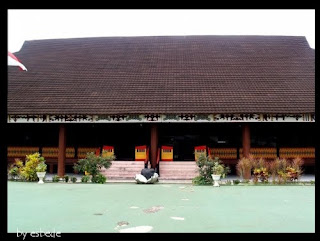Reog Banjarharjo is one of the traditional art that developed in the central region precisely in the District Brebes Banjarharjo endangered. Unlike the reog that as long as we know from Ponorogo, East Java. Featured in the show Reog Ponorogo mask lion-shaped head, known as "Singa Barong", king of the jungle, which became a symbol for Kertabumi, and above it is plugged in peacock feathers to resemble a giant fan. But reog Brebes origin, played by two masked men.
Characteristic
Reog Banjarharjo played by two people, one person featured as a good person, and one evil character. The good guy wearing a mask pins, and the evil Barongan. These two play fighting when the show takes place. Her story is told about the spirits that inhabited a place or house. When the house would be occupied, the pins come to drive away spirits (Barongan). Both are usually fought first, until eventually won by pin.
To enliven the attraction that the two figures, accompanied by music played seven one interpreter Kawi or sinden. Namely, the four people carrying tetabuhan like drums are carried in front, one man plays trumpets, gongs and one kecrek. Tetabuhan drum beaten with a stick, while dancing to the music.
Preservation
In Banjarharjo now there is only one group reog Puspa Mulya, reog existence is almost extinct. Kesenia This is the legacy of ancestors who played for generations. From ancient times many people who like kesenia Banjarharjo this, but along with the development of modern technology, the arts are very rarely played and is now living reog group Puspa Mulya
First, this art is displayed for the occasion to move house, or Ruwatan home. But in its development is now played in celebration of a wedding or circumcision ceremony.
Communities like this art, because it has collaborated with music jaipong. So the audience can come dance to the music.
Characteristic
Reog Banjarharjo played by two people, one person featured as a good person, and one evil character. The good guy wearing a mask pins, and the evil Barongan. These two play fighting when the show takes place. Her story is told about the spirits that inhabited a place or house. When the house would be occupied, the pins come to drive away spirits (Barongan). Both are usually fought first, until eventually won by pin.
To enliven the attraction that the two figures, accompanied by music played seven one interpreter Kawi or sinden. Namely, the four people carrying tetabuhan like drums are carried in front, one man plays trumpets, gongs and one kecrek. Tetabuhan drum beaten with a stick, while dancing to the music.
Preservation
In Banjarharjo now there is only one group reog Puspa Mulya, reog existence is almost extinct. Kesenia This is the legacy of ancestors who played for generations. From ancient times many people who like kesenia Banjarharjo this, but along with the development of modern technology, the arts are very rarely played and is now living reog group Puspa Mulya
First, this art is displayed for the occasion to move house, or Ruwatan home. But in its development is now played in celebration of a wedding or circumcision ceremony.
Communities like this art, because it has collaborated with music jaipong. So the audience can come dance to the music.












 10:51 AM
10:51 AM
 Ahmad Fahrudin
Ahmad Fahrudin




































